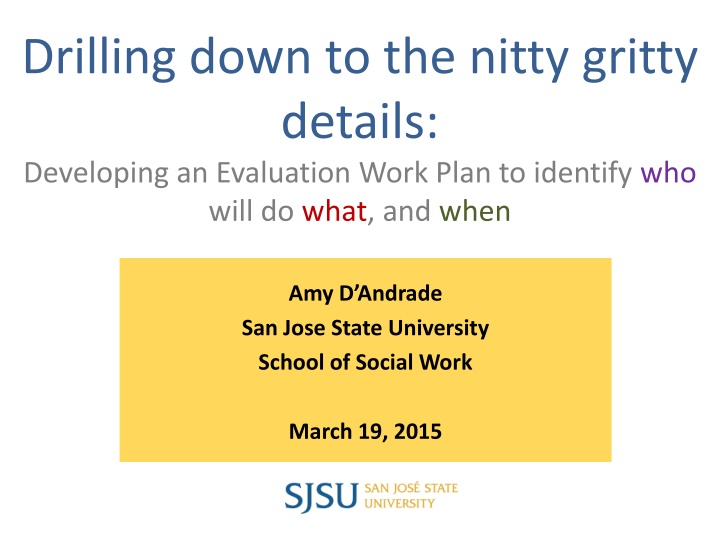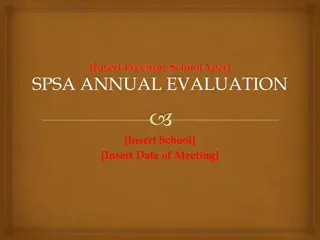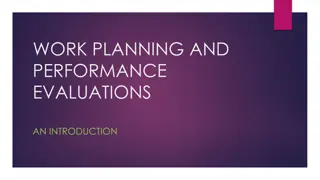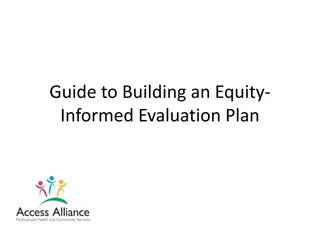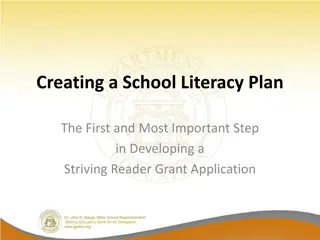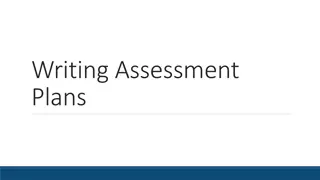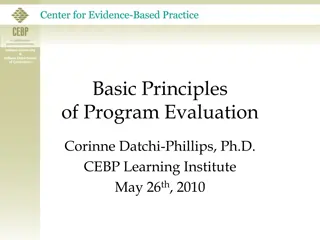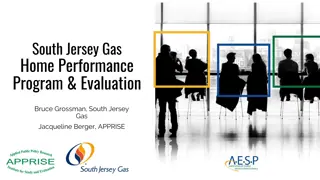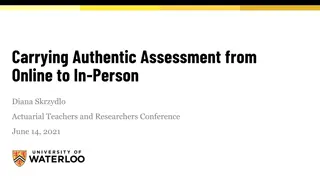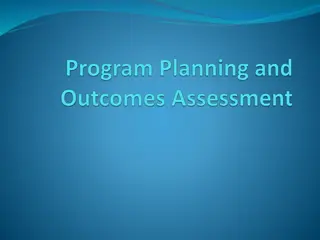Developing an Evaluation Work Plan for Effective Program Assessment
This presentation by Amy D. Andrade from San Jose State University focuses on developing an Evaluation Work Plan to identify responsibilities and timelines. It covers topics such as Evaluation Coaching Support, Webinar Outlines, Logic Model, Inputs-Outputs-Outcomes, Two Approaches to Evaluation, Process Evaluation, Data Analysis, and Common Issues/Lessons Learned in evaluation processes.
Download Presentation

Please find below an Image/Link to download the presentation.
The content on the website is provided AS IS for your information and personal use only. It may not be sold, licensed, or shared on other websites without obtaining consent from the author.If you encounter any issues during the download, it is possible that the publisher has removed the file from their server.
You are allowed to download the files provided on this website for personal or commercial use, subject to the condition that they are used lawfully. All files are the property of their respective owners.
The content on the website is provided AS IS for your information and personal use only. It may not be sold, licensed, or shared on other websites without obtaining consent from the author.
E N D
Presentation Transcript
Drilling down to the nitty gritty details: Developing an Evaluation Work Plan to identify who will do what, and when Amy D Andrade San Jose State University School of Social Work March 19, 2015
Evaluation Coaching Support Intensive coaching with 3 focus counties: Madera, Los Angeles, Tulare Peer cluster on-line evaluation webinars Available by email to both groups: amy.dandrade@sjsu.edu
Webinar Outline 1. Background context 2. Evaluation element options 3. The evaluation work plan 4. Examples: Focus county plans 5. Experiences and lessons learned
The Logic Model .. a simple diagram that communicates the rationale for why a program will work. - Linkages Toolkit
INPUTS OUTPUTS OUTCOMES Short Medium Participation/ Long- term Activities Program resources What we invest What we do Who we reach What results we obtain
Two Approaches to Evaluation Outcome Evaluation: Outcome Evaluation: Using empirical data to assess the impacts or outcomes of programs Process Evaluation: Process Evaluation: Using empirical data to assess the delivery of programs
Typical process evaluation questions Were program activities accomplished? How well were activities executed? Did the right group participate or receive the activity? Did enough people from the right group participate or receive the activity? What got in the way?
Beginning to think about data What kinds of data could we use? Qualitative data (words) Interviews Observations
Common Issues and Lessons Learned Creating a logic model takes time All counties felt implementation not as strong as desired All counties selected a process evaluation for their focus No county had ready data to quantify implementation Recurring concerns about outcomes
Evaluation Element Options 1 Implementation Tracking 2 Process Investigation Case Studies 3 4 Outcomes Option 5 Dissemination
INPUTS ACTIVITIES OUTCOMES Services offered not duplicative Development of coordinated case plan Linkages Team Increased case closure CWS / DPSS Families better able to complete case plan requirements Case plans and casework draw on knowledge and resources of both divisions DPSS staff Greater service availability/ fewer wait- lists DPSS staff attends TDMs CWS staff Service providers Families more likely to receive needed supports Regular communication between DPSS and CWS workers Decreased re-entry CWS / renewal DPSS Services offered provide for more family needs Families CFPIC Training for CWS staff on Linkages All eligible families receive Linkages services [To Linkages activities 1,2,3] Identification of shared families
INPUTS ACTIVITIES OUTCOMES Services offered not duplicative Development of coordinated case plan Linkages Team Increased case closure CWS / DPSS Families better able to complete case plan requirements Case plans and casework draw on knowledge and resources of both divisions DPSS staff Greater service availability/ fewer wait- lists DPSS staff attends TDMs CWS staff Service providers Families more likely to receive needed supports Regular communication between DPSS and CWS workers Decreased re-entry CWS / renewal DPSS Services offered provide for more family needs Families CFPIC Training for CWS staff on Linkages All eligible families receive Linkages services [To Linkages activities 1,2,3] Identification of shared families 1 Implementation Tracking
INPUTS ACTIVITIES Development of coordinated case plan Linkages Team DPSS staff Interview DPSS staff to find out why they aren t attending TDMs. DPSS staff attends TDMs CWS staff Service providers Regular communication between DPSS and CWS workers Families CFPIC Training for CWS staff on Linkages Identification of shared families 2 Process Investigation
INPUTS ACTIVITIES OUTCOMES Services offered not duplicative Development of coordinated case plan Linkages Team Increased case closure CWS / DPSS Families better able to complete case plan requirements Case plans and casework draw on knowledge and resources of both divisions DPSS staff Greater service availability/ fewer wait- lists DPSS staff attends TDMs CWS staff Service providers Families more likely to receive needed supports Regular communication between DPSS and CWS workers Decreased re-entry CWS / renewal DPSS Services offered provide for more family needs Families CFPIC Training for CWS staff on Linkages For successful families how did Linkages help? What was the process or mechanism by which it helped? All eligible families receive Linkages services [To Linkages activities 1,2,3] Identification of shared families 3 Case Studies
INPUTS ACTIVITIES OUTCOMES Services offered not duplicative Development of coordinated case plan Linkages Team Increased case closure CWS / DPSS Families better able to complete case plan requirements Case plans and casework draw on knowledge and resources of both divisions DPSS staff Greater service availability/ fewer wait- lists DPSS staff attends TDMs CWS staff Service providers Families more likely to receive needed supports Regular communication between DPSS and CWS workers Decreased re-entry CWS / renewal DPSS Services offered provide for more family needs Families CFPIC Training for CWS staff on Linkages What % of Linkage cases reunified? All eligible families receive Linkages services [To Linkages activities 1,2,3] Identification of shared families What percentage became employed? 4 Outcomes Option
5 Dissemination
The Evaluation Work Plan Task Person Responsible Estimated Time Involved Time Frame Progress and Next Steps
1 Implementation Tracking
1 Implementation Tracking
Sparked by outreach of CW case worker to W2W case manager 2 Process Investigation
2 Process Investigation
How did Linkages help? What did the process look like? 3 Case Studies
3 Case Studies
4 Outcomes Option
4 Outcomes Option
5 Dissemination
Experiences and lessons learned Amy s lessons: Distance is challenging Work in process Helpful to get the concrete details down County feedback? Overwhelming or reassuring?
Evaluation Work Plan Resources Developing an Effective Evaluation Plan. Atlanta, Georgia: Centers for Disease Control and Prevention, National Center for Chronic Disease Prevention and Health Promotion, Office on Smoking and Health; Division of Nutrition, Physical Activity, and Obesity, 2011. http://www.cdc.gov/obesity/downloads/CDC-Evaluation-Workbook- 508.pdf Examples of Evaluation Plans. The Community Tool Box, Evaluating Community Programs and Initiatives. University of Kansas. http://ctb.ku.edu/en/table-of- contents/evaluate/evaluation/evaluation-plan/examples
Questions? amy.dandrade@sjsu.edu
